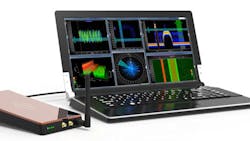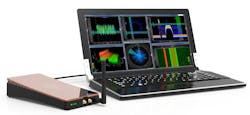This file type includes high resolution graphics and schematics when applicable.
Spectrum monitoring is becoming an everyday event, given the growing number of wireless devices vying for their own “spectral territories.” Unlicensed frequency bands, such as 2.45 GHz, are becoming overcrowded with communications signals. Measurement tools (e.g., spectrum analyzers) are helping to avoid spectral clutter and interference, achieving co-existence among these many wireless signals.
And fortunately, spectrum analyzers like the RFeye Nexus Desktop DR-8 from CRFS are evolving to meet the measurement needs of this ever-changing wireless environment, packing sensitive and accurate measurement capabilities from 9 kHz to 8 GHz into a package that can truly fit into the palm of your hand.
The RFeye Desktop spectrum analyzer (see photo) works with a laptop or other PC to make simple spectral measurements in the field. The analyzer is supported via with different online measurement applications that allow such functions as signal monitoring, interference hunting, and even testing for electromagnetic interference (EMI) and electromagnetic compatibility (EMC).
The pocket-sized instrument’s looks are deceiving: It appears nothing like the traditional portable spectrum analyzer with large screen and handle. Weighing less than 1 kg and relying on the computer’s microprocessor for programming and the computer’s display screen for information readouts, this analyzer looks more like the commercial wireless communications devices it is measuring. Yet, the compact package houses a highly sensitive, wide-dynamic-range radio receiver with the low phase noise needed to detect and correctly identify different signals across its frequency span.
In addition to its wide frequency bandwidth, the spectrum analyzer has the measurement agility to spot frequency-hopping signals. It provides instantaneous measurement bandwidths as wide as 100 MHz that can be swept across its total frequency range at speeds to 400 GHz/s. The analyzer features frequency tuning resolution of 1 Hz for studying the finest details of a captured signal. Its wide dynamic range is punctuated by excellent sensitivity, established by excellent phase-noise performance and low noise figures.
For example, the single-sideband (SSB) phase noise is less than −125 dBc/Hz offset 20 kHz from carriers below 0.5 GHz and less than −115 dBc/Hz offset 20 kHz from carriers greater than 1 GHz. The typical noise figures are 12 dB from 9 kHz to 100 MHz, 7 dB from 100 MHz to 2.4 GHz, and 8 dB from 2.4 to 8.0 GHz.
The RFeye Nexus Desktop DR-8 portable spectrum analyzer is supported by a company with a strong background in measuring spectral activity and with a number of effective software tools for use with its different hardware instruments. RFeye Monitor software, for example, is networked software that monitors and collects spectrum data through 6 GHz from numerous networked RFeye Nodes. It can be programmed with frequency masks and alarms, as well as used to check spectrum activity and occupancy per licenses and regulations.
The RFeye Desktop Nexus DR-8 is equipped with a USB 3.0 port, along with three female SMA connectors for RF/microwave signal interconnections (e.g., to antennas for remote spectrum monitoring). The spectrum analyzer can be run through a browser on any Windows- or Linux-compatible PC. The firm expects that RFeye Desktop users will take advantage of its online software measurement tools, but will also contribute some of their own measurement software applications as they learn more about the capabilities of this palm-sized RF/microwave spectrum analyzer.
CRFS Inc., 4230-D Lafayette Center Dr., Chantilly, VA 20151; (571) 321-5470
This file type includes high resolution graphics and schematics when applicable.
About the Author
Jack Browne
Technical Contributor
Jack Browne, Technical Contributor, has worked in technical publishing for over 30 years. He managed the content and production of three technical journals while at the American Institute of Physics, including Medical Physics and the Journal of Vacuum Science & Technology. He has been a Publisher and Editor for Penton Media, started the firm’s Wireless Symposium & Exhibition trade show in 1993, and currently serves as Technical Contributor for that company's Microwaves & RF magazine. Browne, who holds a BS in Mathematics from City College of New York and BA degrees in English and Philosophy from Fordham University, is a member of the IEEE.



